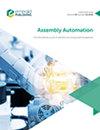A peg-in-hole controller for cable-driven serial robots with compliant wrist based on cable tensions and joint positions
IF 1.7
4区 计算机科学
Q3 AUTOMATION & CONTROL SYSTEMS
引用次数: 0
Abstract
Purpose This purpose of this paper is to design a peg-in-hole controller for a cable-driven serial robot with compliant wrist (CDSR-CW) using cable tensions and joint positions. The peg is connected to the robot link through a CW. It is required that the controller does not rely on any external sensors such as 6-axis wrist force/torque (F/T) sensor, and only the compliance matrix’s estimated value of the CW is known. Design/methodology/approach First, the peg-in-hole assembly system based on a CDSR-CW is analyzed. Second, a characterization algorithm using micro cable tensions and joint positions to express the elastic F/T at the CW is established. Next, under the premise of only knowing the compliance matrix’s estimate, a peg-in-hole controller based on force/position hybrid control is proposed. Findings The experiment results show that the plug contact F/T can be tracked well. This verifies the validity and correctness of the characterization algorithm and peg-in-hole controller for CDSR-CWs in this paper. Originality/value First, to the authors’ knowledge, there is no relevant work about the peg-in-hole assembly task using a CDSR-CW. Besides, the proposed characterization algorithm for the elastic F/T makes the peg-in-hole controller get rid of the dependence on the F/T sensor, which expands the application scenarios of the peg-in-hole controller. Finally, the controller does not require an accurate compliance matrix, which also increases its applicability.基于电缆张力和关节位置的柔性手腕电缆驱动串行机器人孔内钉控制器
目的本文的目的是利用电缆张力和关节位置为具有柔顺手腕的电缆驱动串行机器人(CDSR-CW)设计一种插孔控制器。销钉通过CW连接到机器人连杆。要求控制器不依赖于任何外部传感器,例如6轴手腕力/扭矩(F/T)传感器,并且只有顺应性矩阵的CW的估计值是已知的。设计/方法/途径首先,分析了基于CDSR-CW的孔内装配系统。其次,建立了一种利用微索张力和接头位置来表达连续波弹性F/T的表征算法。其次,在只知道柔度矩阵估计的前提下,提出了一种基于力/位置混合控制的嵌孔控制器。实验结果表明,插塞接触F/T可以很好地跟踪。这验证了本文提出的CDSR CWs特征化算法和孔内控制器的有效性和正确性。独创性/价值首先,据作者所知,目前还没有关于使用CDSR-CW的钻孔装配任务的相关工作。此外,所提出的弹性F/T的特征化算法使孔内控制器摆脱了对F/T传感器的依赖,拓展了孔内控制器的应用场景。最后,控制器不需要精确的顺应性矩阵,这也增加了它的适用性。
本文章由计算机程序翻译,如有差异,请以英文原文为准。
求助全文
约1分钟内获得全文
求助全文
来源期刊

Assembly Automation
工程技术-工程:制造
CiteScore
4.30
自引率
14.30%
发文量
51
审稿时长
3.3 months
期刊介绍:
Assembly Automation publishes peer reviewed research articles, technology reviews and specially commissioned case studies. Each issue includes high quality content covering all aspects of assembly technology and automation, and reflecting the most interesting and strategically important research and development activities from around the world. Because of this, readers can stay at the very forefront of industry developments.
All research articles undergo rigorous double-blind peer review, and the journal’s policy of not publishing work that has only been tested in simulation means that only the very best and most practical research articles are included. This ensures that the material that is published has real relevance and value for commercial manufacturing and research organizations.
 求助内容:
求助内容: 应助结果提醒方式:
应助结果提醒方式:


